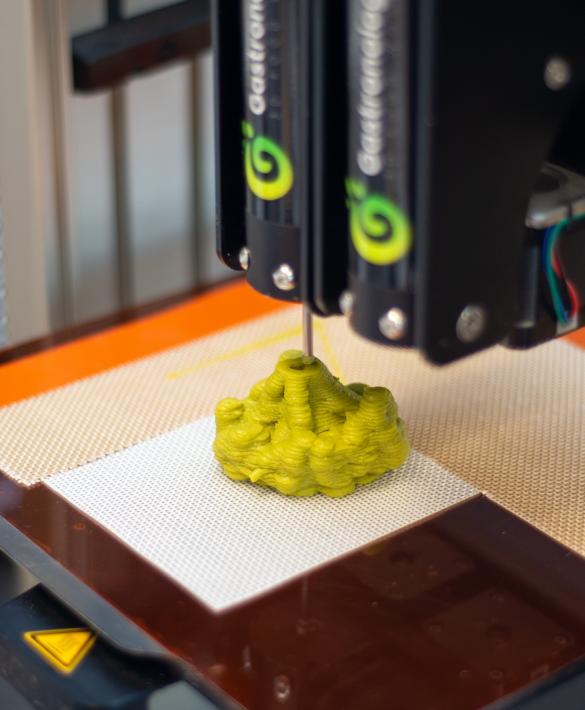Food 3D printing has, in many ways, been an additive manufacturing (AM) segment looking for the right business case. While some applications are beautiful and others may or may not impact meat consumption, the technology can be difficult to scale. One area with promise is the 3D printing of food for individuals with chewing and swallowing difficulties, an issue referred to as dysphagia. This use case has been explored for nearly a decade but has so far never been fully commercialized. That is, until now: Dutch startup Gastronology 3D Food Works has announced that it has commenced industrial production of 3D printed food products for dysphagia patients.
How it Works
Gastronology has developed a line of food products that cater to the needs of individuals with conditions such as ALS, MS, or Huntington’s disease, which often result in significant eating challenges. By transforming freshly prepared purees into what the company suggests is aesthetically pleasing and nutritionally rich 3D-printed food, the company aims to ensure that patients receive both the necessary sustenance and an enjoyable eating experience.

Founded in 2019, Gastronology has developed a food 3D printing technology that relies on a purée of vegetables, chicken, fish, or potatoes. The industrial food printer deposits the material to create food objects up to 6 centimeters high. Once printed, they are frozen to at least -18°C to preserve quality and then packed for storage in climate-controlled facilities. To serve, the frozen 3D food items are simply reheated, maintaining their shape through the warming process.
Scaling up 3D Printed Food
Researchers from Wageningen University & Research, TNO, and Eindhoven University of Technology, have helped Gastronology improve the texture of the food, with input from Lamb Weston/Meijer and Ruitenberg Ingredients. After a series of successful test runs from September 2023 to March 2024, Gastronology has officially started production with a capacity of 700 kilograms per day. Plans are underway to increase this capacity to 2,500 kilograms per day to cater to approximately 15,000 individuals.

Gastronology licenses this technology via several options: purchasing premixes to prepare and print recipes, buying ready-to-print semi-finished purées, or obtaining completely printed end products, with the manufacturing process fully outsourced. Licensees gain access to Gastronology’s food 3D printing technology, designs, and techniques, contributing a fee per unit and incorporating the Gastronology branding as part of the packaging, while also investing in the necessary software and hardware.
The firm’s recipes are made up of fresh ingredients combined with minimal added flavorings and binders, meant to result in a non-sticky yet smooth texture suitable for 3D printing and consumption. With recipes and designs created by SVH master chef Eugène Swalen, the 3D printed food is designed to be visually appealing and flavorful, one of the biggest drawbacks of traditional pureed and blended foods.
Dysphalicious 3D Printed Food
Gastronology’s Dysphalicious product line includes eight different products made from potatoes and vegetables. These will be distributed to selected care institutions and hospitals participating in a pilot project starting mid-April. The project aims to evaluate the practical usability of these products in healthcare settings and gather feedback on patient satisfaction.

Budelfood is set to become the first industrial-scale manufacturer of 3D printed food under a Gastronology license starting in 2024. The company will prepare, print, and package the 3D printed food products at its certified facility in Poortvliet, with offerings that include finished products and ingredient premixes for both the healthcare and broader food sectors. The company is part of the larger Budelpack Group, which creates food packaging for some of the largest manufacturers in the world, including Mondelēz International, MARS, Nestlé, Wrigley, Unilever, and Kraft Heinz.
Gastronology suggests that the technology not only aids dysphagia patients, but also reduces food waste and mitigates the effects of food production on climate change. This is achieved through customized portion sizes to minimize leftovers and extending product longevity with frozen semi-finished items. Whether or not this is true, the company does seem to be on the path to successfully commercializing 3D printed food for a very real applications and market. In turn, it could be among the first to anchor 3D printed food in the real world.
All images courtesy of Gastronology.
Subscribe to Our Email Newsletter
Stay up-to-date on all the latest news from the 3D printing industry and receive information and offers from third party vendors.
Print Services
Upload your 3D Models and get them printed quickly and efficiently.
You May Also Like
The Dental Additive Manufacturing Market Could Nearly Double by 2033, According to AM Research
According to an AM Research report from 2024, the medical device industry, specifically in dentistry, prosthetics, and audiology, is expected to see significant growth as these segments continue to benefit from...
Heating Up: 3D Systems’ Scott Green Discusses 3D Printing’s Potential in the Data Center Industry
The relentless rise of NVIDIA, the steadily increasing pledges of major private and public investments in national infrastructure projects around the world, and the general cultural obsession with AI have...
AM Research Webinar Explores Continuum’s Sustainable Metal Additive Manufacturing Powders
Metal additive manufacturing (AM) powder supplier Continuum Powders is working to develop solutions that empower industries to reduce waste and optimize their resources. An independent life cycle assessment (LCA) of...
3D Printed Footwear Startup Koobz Lands $7.2M in Seed Round
California-based Koobz is focused on reshoring the U.S. footwear supply chain with advanced manufacturing processes, including 3D printing. The startup just announced that it has added $6 million to its...
































